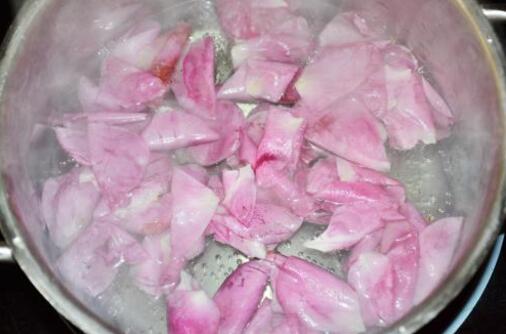
Here's all you need to know to make your own rose water.
Choosing the rose petals
Choosing your fragrance
If the aroma of your rose water is important to you, the color of the rose petals you choose makes all the difference.
The University of Vermont Extension Department of Plant and Soil Science explains that not all roses smell rosey. Red and pink roses with deeper colors and thick or velvety petals are the ones that have the traditional rose smell. White and yellow roses frequently have the fragrance of violets, nasturtium and lemon. Roses that are orange have more a fruit aroma as well as scents of violets, nasturtium and clove.
Distilling rose water
There are two methods you can use when making rose water at home. The first is distillation. Distillation creates a more concentrated rose water that will last longer than the infusion method. Distilling yields less rose water, but it's a fairly easy process.
You can distill rose water using tools you probably already have in your kitchen. You'll need a large pot with a lid, a glass bowl that has a smaller diameter than the pot, and bags full of ice.
To distill rose water, follow these steps:
1、Rinse your rose petals if they are fresh to get rid of any dirt or bugs that may be on them.
2、Put the bowl into the center of the pot and place your petals around the bowl.
3、Add just enough water to cover the rose petals. Make sure the water doesn't come over the top of the bowl.
4、Put the lid onto the pot, upside-down. (As water condenses on the lid, the upside-down lid will help it move to the middle of the lid and then drop into the bowl.) If you have a glass lid, you can see the distillation process in action, but you can use a solid lid, too.
5、Place the bag of ice on top of the lid, it aids in creating condensation.
6、Turn the burner on to medium (you don't want to boil the water) and let the distillation process begin.
7、If your bag of ice melts, replace it with another.
8、In about 20-25 minutes you should have a good amount of distilled rose water in the bowl. How long you need to keep it going will depend on how many rose petals you've added. When the color of the roses petals have faded, you should stop distilling.
9、Pour the water into a clean jar or spray bottle.
10、Store in the refrigerator.
Infusing rose water
You can also infuse water with roses, which will create a colored rose water that's not as concentrated as the distilled version.
To infuse rose water, follow these steps:
1、Rinse your rose petals if they are fresh to get rid of any dirt or bugs that may be on them.
2、Put the petals in a pot and pour water over them, just enough to cover the petals.
3、Bring the water to a simmer, then turn the heat so it's just below a simmer. You don't want to bring the water to a boil.
4、Continue to heat the petals until they lose most of their color.
5、Remove from heat and strain the petals from the water.
6、If you want to get a more concentrated color, squeeze the petals to get as much water out of them as possible, and then pour that water through the strainer and into the water that has already been strained.
7、Pour the water into a glass jar or a spray bottle.
8、Store in the refrigerator.
Uses for rose water
Now that you have rose water, what are you going to do with it? Here are some of its uses, although results will vary.
Drink it: The vitamins, minerals and essential oils work from the inside out when you drink rose water. Although there have not been many scientific tests on rose water, it's been used for centuries to do everything from treating depression to soothing a sore throat to combating inflammation.
Make a cocktail: The floral flavors in rose water make it complementary with spirits like gin. This Rose Water Gin Cocktail turns plain rose water into simple syrup and then adds it to gin, lemon juice and club soda for a refreshing drink.
Reduce puffy eyes: Place two cotton balls soaked in rose water under your eyes and the anti-inflammatory properties in the water may help reduce puffiness (which may have been caused by too many rose water cocktails.)
Sooth irritated skin: Spritz right onto skin for eczema or rosacea flair ups.
Spray it on like cologne: Rose water takes on the scent of the rose petals, so it can be used as an all-natural cologne.
Rose water also has antiseptic and anti-bacterial properties, but treating a wound — even a small one — is a serious issue. Reach for a product like Neosporin or a doctor-prescribed antibiotic to treat an infection, or, if you want to try the rose water method, consult a doctor beforehand.







